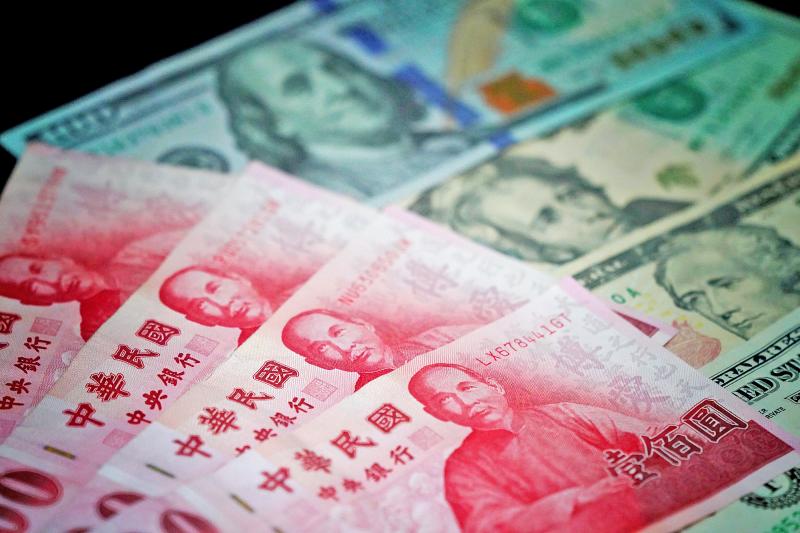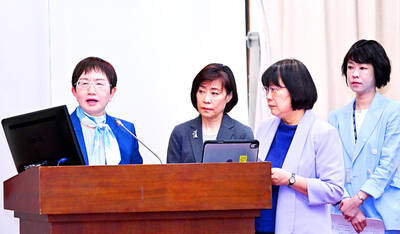Taiwan’s foreign exchange reserves last month totaled US$544.9 billion, rising US$1.32 billion from August to a record for the second straight month, the central bank said yesterday, crediting foreign-exchange management.
Department of Foreign Exchange Director-General Eugene Tsai (蔡炯民) said that the US dollar gained 1.73 percent last month, allowing the bank’s investment gains to more than absorb unfavorable exchange twists.
A US Federal Reserve plan to taper its bond purchasing program, with some Fed members suggesting a full exit by March next year, has lent support to US government bonds, as shown by an upswing in 10-year bond yields, Tsai said.

Photo: CNA
The trend bolstered the US dollar and greenback-based investment tools, Tsai said, adding that local exchange-traded funds (ETFs) were among the tools that moved.
That explained why foreign portfolio investors trimmed their holdings in local shares and New Taiwan dollar deposits, which totaled US$691.3 billion last month, or 1.27 times the value of the nation’s foreign exchange reserves, he said.
Fund outflows continued this month, putting correction pressure on the TAIEX, he said.
However, the NT dollar was resilient, supported mainly by strong exports, Tsai said.
The central bank in March acted to stabilize the local currency, but its interventions have slackened over the past six months, as supply and demand have normalized somewhat, he said.
Taiwan remained the world’s fifth-largest holder of foreign exchange reserves, trailing China, Japan, Switzerland and India, the central bank said.

‘SWASTICAR’: Tesla CEO Elon Musk’s close association with Donald Trump has prompted opponents to brand him a ‘Nazi’ and resulted in a dramatic drop in sales Demonstrators descended on Tesla Inc dealerships across the US, and in Europe and Canada on Saturday to protest company chief Elon Musk, who has amassed extraordinary power as a top adviser to US President Donald Trump. Waving signs with messages such as “Musk is stealing our money” and “Reclaim our country,” the protests largely took place peacefully following fiery episodes of vandalism on Tesla vehicles, dealerships and other facilities in recent weeks that US officials have denounced as terrorism. Hundreds rallied on Saturday outside the Tesla dealership in Manhattan. Some blasted Musk, the world’s richest man, while others demanded the shuttering of his

ADVERSARIES: The new list includes 11 entities in China and one in Taiwan, which is a local branch of Chinese cloud computing firm Inspur Group The US added dozens of entities to a trade blacklist on Tuesday, the US Department of Commerce said, in part to disrupt Beijing’s artificial intelligence (AI) and advanced computing capabilities. The action affects 80 entities from countries including China, the United Arab Emirates and Iran, with the commerce department citing their “activities contrary to US national security and foreign policy.” Those added to the “entity list” are restricted from obtaining US items and technologies without government authorization. “We will not allow adversaries to exploit American technology to bolster their own militaries and threaten American lives,” US Secretary of Commerce Howard Lutnick said. The entities

Minister of Finance Chuang Tsui-yun (莊翠雲) yesterday told lawmakers that she “would not speculate,” but a “response plan” has been prepared in case Taiwan is targeted by US President Donald Trump’s reciprocal tariffs, which are to be announced on Wednesday next week. The Trump administration, including US Secretary of the Treasury Scott Bessent, has said that much of the proposed reciprocal tariffs would focus on the 15 countries that have the highest trade surpluses with the US. Bessent has referred to those countries as the “dirty 15,” but has not named them. Last year, Taiwan’s US$73.9 billion trade surplus with the US

Prices of gasoline and diesel products at domestic gas stations are to fall NT$0.2 and NT$0.1 per liter respectively this week, even though international crude oil prices rose last week, CPC Corp, Taiwan (台灣中油) and Formosa Petrochemical Corp (台塑石化) said yesterday. International crude oil prices continued rising last week, as the US Energy Information Administration reported a larger-than-expected drop in US commercial crude oil inventories, CPC said in a statement. Based on the company’s floating oil price formula, the cost of crude oil rose 2.38 percent last week from a week earlier, it said. News that US President Donald Trump plans a “secondary